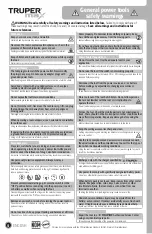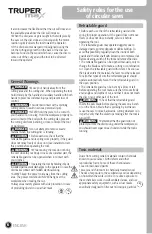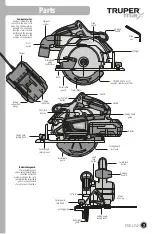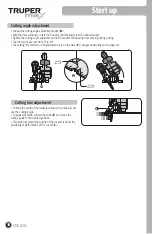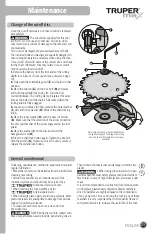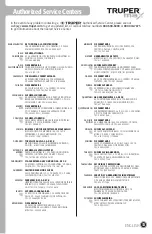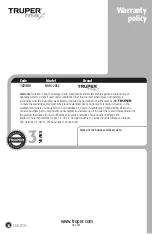
6
Retractable guard
General Warnings
• Before each use check the retractable guard and its
spring for proper operation, if the guard does not move
freely or does not close instantly, service it before
operating the tool.
• The retractable guard may operate sluggishly due to
damaged parts, gummy deposits or debris buildup. To
avoid this possibility, regularly clean the inside of both
guards and the disc shaft with kerosene or compressed air.
Before cleaning, switch off the tool and remove the discs.
• The retractable guard can be opened manually, only to
change the blades and to make a cutting or combination
cut. Open the retractable guard with its lever. As soon as
the blade enters the material, the lever must be released.
For all other types of cuts the retractable guard should
operate automatically. Never fix the retractable guard in
the open position.
• The retractable guard can be bent by a blow or fall.
Before operating the tool make sure that it moves freely
at all angles and depths of cut, and that it does not touch
the disc or any other part of the tool.
• Check that the retractable guard
covers the saw blade before placing the saw on a bench
or on the floor. A blade that is spinning by inertia can
cause the saw to move backwards, cutting whatever is in
its path. Verify that the disk stops moving after the tool is
turned off.
• Remember that the guards do not
protect you from the disc moving under the workpiece, so
you should never squat or reach under it while the tool is
running.
Dusts from cutting certain materials contain chemicals
known to cause cancer, birth defects and other
reproductive harm. Some of these chemicals are:
• Lead in lead-based paints.
• Arsenic and chromium in chemically treated wood.
The risk of exposure to these substances varies depending
on how often the work is done. To reduce exposure to
these chemicals, work in well-ventilated areas, and use
appropriate safety equipment, such as dust masks
specifically designed to filter out microscopic particles.
Toxic materials
• Move your hands away from the
cutting area and the cutting disc. When operating the tool
hold it firmly by the handle and auxiliary handle with both
hands to prevent accidental injury and prevent loss of
control.
• Accidental contact with a spinning
cutting disc can result in serious personal injury.
• NEVER hold the piece to be cut with
your hands or on one leg. Hold the workpiece properly to
avoid contact of the body with the cutting disc, prevent
the cutting disc from bending, or lose control of the tool
or workpiece.
• Do not attempt to remove waste
material when the cutting disc is rotating.
• Before each use check that the
retractable guard and its spring work properly, if the guard
does not move freely or does not close instantly correct
this points before operating the tool.
• While moving the tool do not bring
the disc close to your body. In case of accidental start, the
retractable guard can be opened when in contact with
your clothes.
• Operating the tool by holding it by its
insulated parts avoids discharges to the operator in case the
disc makes contact with hidden electrical wiring.
• ALWAYS keep the power cord away from the cutting
area. The power cord should NEVER hang over the
workpiece when making the cut.
• Always wear safety glasses with side protection. In case
of producing dust also use a dust mask.
It also increases the likelihood that the cut will close and
the available area above the disc will increase.
• When the disc jams or gets caught in the workpiece by
the saw cut, the disc stops and consequently the motor
reaction quickly directs the tool toward the operator.
• If the disc becomes warped or misaligned during the
cut, the cutting-edge teeth on the back of the disc can
become buried in the wood which can cause the disc to
come out of the cut gap and the tool to be directed
toward the operator.
Safety rules for the use
of circular saws
ENGLISH
DANGER
DANGER
DANGER
CAUTION
CAUTION
WARNING
WARNING
WARNING
WARNING
Summary of Contents for 102480
Page 12: ...Notes 12 ENGLISH ...
Page 17: ...Notas 12 ESPAÑOL ...




